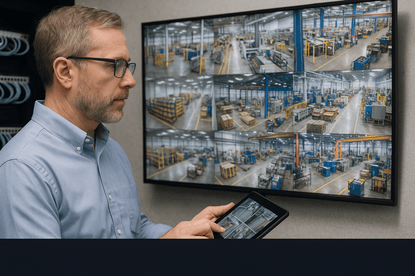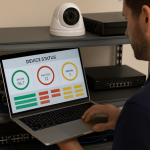
For growing manufacturers, operating across multiple facilities comes with plenty of upside—more capacity, closer proximity to key markets, better distribution.
But when it comes to Environmental, Health, and Safety (EHS) compliance, multi-site operations present a serious challenge: how do you maintain consistent safety and security standards across every location?
Different buildings. Different teams. Different hazards. Often, different rules.
That’s where a centralized security infrastructure becomes more than just an IT or operations asset—it becomes a powerful tool for maintaining consistent EHS performance.
Let’s talk about what that looks like, why it matters, and how SSP helps manufacturers protect operations, people, and property across every facility.
k
k
The Problem: Safety Standards Don’t Always Scale
EHS managers know that safety policies are only as strong as their implementation. And while you may have rock-solid protocols at your headquarters plant, it’s much harder to know what’s happening at:
- A remote fabrication site
- A distribution warehouse
- A recently acquired facility
- A contract manufacturing partner’s floor
Without standardized monitoring, access control, and incident response, safety practices can slip—and so can compliance.
k
k
The Solution: Centralized Security Built for EHS Oversight
A centralized security infrastructure ties all your facilities into one unified system—for access control, surveillance, intercoms, and emergency response tools. That’s where SSP comes in.
We help industrial clients design and implement security platforms that not only monitor access and prevent intrusion, but also support:
- EHS reporting
- Real-time event response
- Safety investigations
- Regulatory compliance audits
Here’s how.
1. Unified Access Control = Consistent Safety Protocols
With a centralized access control system:
- Badge permissions are managed from a single interface.
- EHS policies—like required entry training for high-risk zones—can be enforced across every site.
- You know exactly who accessed what area, when, and for how long.
This helps meet compliance for OSHA, ISO 45001, and industry-specific safety standards.
SSP works with manufacturing clients to roll out cloud-managed access platforms that scale across regions, plants, and shift structures—without needing separate logins or siloed systems.
k
k
2. Centralized Surveillance Helps Spot Safety Gaps Anywhere
When surveillance is unified:
- Leadership and safety teams can view footage from any facility in one dashboard.
- Incident investigation becomes faster, clearer, and more accurate.
- You get consistent video retention policies, access logs, and privacy compliance.
SSP designs plant surveillance systems that work together—across buildings and campuses. That means when a forklift incident happens in Tennessee, your EHS team in Georgia can pull video, cross-check access logs, and update safety procedures across the board.
k
k
3. Shared Emergency Tools and Protocols
With SSP’s integrated safety systems, you can standardize:
- Duress buttons and panic stations
- Intercoms at entry/exit points
- Voice-down alerts or mobile notifications
- Camera-triggered alarms and lockdown sequences
These features are not just about intrusions—they’re critical for worker protection, chemical spill response, and evacuation coordination.
Whether you're responding to an incident in your main facility or a satellite site, a shared emergency response framework makes every second count.
k
k
4. Better EHS Data = Better Decisions
Centralized systems also mean centralized data. You can:
- Track safety incidents across sites
- Spot repeat violations
- Identify high-risk behaviors
- Benchmark site performance
- Automate access reporting for audits
SSP integrates your surveillance and access systems with cloud reporting tools to give you actionable insights—across all sites, departments, and business units.
k
k
Why It Matters Now
Multi-site manufacturing is growing fast—and so are expectations from regulators, insurers, and supply chain partners.
The ability to prove that you’ve enforced safety protocols across every site isn’t just about compliance. It builds confidence, reduces risk, and protects your workforce.
By connecting your physical security systems, you create a foundation for safer operations—one that doesn’t depend on emails, spreadsheets, or assumptions.
j
j
Final Thoughts: Security That Works for Safety
Manufacturers are investing heavily in EHS—and rightly so. But without the right infrastructure, it’s easy for standards to slip from site to site.
At SSP, we help manufacturers build centralized security systems that scale with their operations and align directly with EHS goals.
Because protecting your people, property, and productivity shouldn’t depend on which building they’re in.
Looking to unify your facility security systems under one EHS-driven platform?
Contact SSP to schedule a walkthrough of centralized solutions for multi-site manufacturers.


